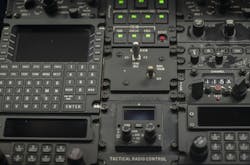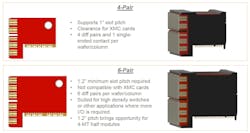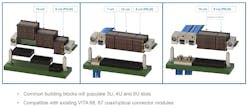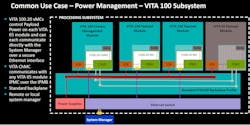What’s New in the VITA 100 Standard (Part 2)
What you’ll learn:
- What new features are in VITA 100 standards?
- Why is 4U a new form factor for VPX?
This video is part 2 of the VITA Basics webinar that you can watch in its entirety.
VITA’s OpenVPX and related standards have stood the test of time, allowing developers of rugged systems for applications like defense and avionics to build modular systems using boards and modules from a variety of sources. VITA 100 looks to extend these standards to handle higher-speed interconnect, provide more power to boards, and increase the number of interface pins.
In this video (above), I talked with Daniel Toohey, a Fellow Chief Technologist within the Advanced Concepts Group at Mercury Systems, Michael Walmsley, Global Product Manager in the Aerospace, Defense and Marine business unit at TE Connectivity, and Mark Littlefield, Senior Manager of Embedded Computing Products and Services for Elma Electronic, about new features included in the VITA 100 set of standards.
Making a Bigger Board: VITA’s Move to 4U
3U and 6U boards have been the norm for decades. A 6U board actually provides more space than two 3U boards, but the differences tended to be minor and the components used to be smaller. These days, chips have become significantly larger and hotter, requiring more power to the point where 3U boards can't accommodate them. Moving to 6U is a significant jump.
Enter the 4U board (Fig. 1).
The 4U is marginally larger than a 3U board, but it's sufficient to handle the newer, larger chips. It can manage proportionally more power and cooling.
3U will remain a significant target for many rugged applications. Likewise, systems already designed for 3U will continue on. However, 4U may be a consideration for new designs where compact, high performance computing (HPC) is pushing the limits.
VITA 100 Brings More Connections
The 400G Ethernet VITA 100 support brings higher bandwidth with the same number of connections. Even so, the demand for more connections in rugged applications continues to grow. One answer is the option to use a 1.2-in. board pitch with new six-pair pin connectors (Fig. 2). The approach uses the same architecture, but it bumps the number of pairs from four to six, which is a 50% improvement with a smaller increase in board pitch.
Flexible board connector designs provide designers with more options, but it's one reason why COTS also has a custom aspect to it (Fig. 3). Not all designs require RF or optical connections. If they do, though, then they can be implemented in a standardized fashion using connections that are included as part of the standard.
System Management is More Functional in VITA 100
The VITA 46.11 Systems Management for VPX is a new standard that will also be part of the VITA 100 suite (Fig. 4). The standard is key in bringing commonality among the chassis-management components and the device-management components in a system so that everything can be centrally managed. It's more than just mandating the use of IPMI for management communications.
About the Author
William G. Wong
Senior Content Director - Electronic Design and Microwaves & RF
I am Editor of Electronic Design focusing on embedded, software, and systems. As Senior Content Director, I also manage Microwaves & RF and I work with a great team of editors to provide engineers, programmers, developers and technical managers with interesting and useful articles and videos on a regular basis. Check out our free newsletters to see the latest content.
You can send press releases for new products for possible coverage on the website. I am also interested in receiving contributed articles for publishing on our website. Use our template and send to me along with a signed release form.
Check out my blog, AltEmbedded on Electronic Design, as well as his latest articles on this site that are listed below.
You can visit my social media via these links:
- AltEmbedded on Electronic Design
- Bill Wong on Facebook
- @AltEmbedded on Twitter
- Bill Wong on LinkedIn
I earned a Bachelor of Electrical Engineering at the Georgia Institute of Technology and a Masters in Computer Science from Rutgers University. I still do a bit of programming using everything from C and C++ to Rust and Ada/SPARK. I do a bit of PHP programming for Drupal websites. I have posted a few Drupal modules.
I still get a hand on software and electronic hardware. Some of this can be found on our Kit Close-Up video series. You can also see me on many of our TechXchange Talk videos. I am interested in a range of projects from robotics to artificial intelligence.





